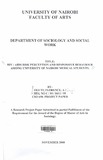| dc.description.abstract | The National development plan (1997-200 1) proclaims HIV/AIDS as the most important
health challenge that Kenya has faced in its post independence history. It is the only known
health problem that has the potential to reverse significant gains made in life expectancy and
infant mortality. The threat posed by the AIDS pandemic in Kenya requires that AIDS control
programmes must move beyond teaching facts on AIDS, if AIDS prevention is to be achieved
(Becker et aI, 1998). Though knowledge about AIDS has been important in reducing risk of
infection, research has proved numerous times that knowledge alone is not sufficient to induce
behaviour change among the individuals (Kiragu et aI, 1993). The prevalence of HIV among
the youth in Nairobi has been increasing and has become an issue of concern especially at the
University of Nairobi (ADEA, 2001, NASCOP, 2001). In addition, available statistics
suggests that University of Nairobi youths involve themselves in high-risk behaviour and if
not checked, leaves little scope for optimism (ADEA, 2001).
The objectives of this study were; to establish HIV / AIDS risk perception among Medical
Students, to establish the responsive behaviour against HIV/AIDS risk perception among the
. Medical Students, to investigate the sources of information on HIV among the Medical
students and also to study how the different sources of information on HIV/ AIDS influence
the HIVI AIDS risk perception and responsive behaviour among Medical Students.
This study was a cross sectional survey where the researcher targeted Medical undergraduate
Students from the University of Nairobi who were aged between 19-25 years old. These
Students were in Medical, Dental, Pharmacy and Nursing faculties. The researcher sampled
130 Students and 10 key informants and all of them gave responses to the questionnaires.
Data was then collected using semi-structured questionnaires and was analyzed using
descriptive statistics. The data was coded and entered into a spreadsheet and analyzed using
SPSS (Statistical Package for Social Sciences) and excel packages and presented using
frequencies, percentages and mean scores and frequency tables, bar graphs and pie charts.
From the study, the researcher found that most of the Medical Students in the University of
Nairobi were already engaged in sexual intercourse. This means that these Students were at
risk of contracting HIV/AIDS. The study also concludes that in order to protect themselves
from contracting the virus, most of the students used condoms regularly. This means that the
students were well informed that condoms were effective in preventing the contraction of
HIV/AIDS. The study also established that people i.e. lecturers, friends and relatives were the
main sources of information to these Students on HIV/AIDS and also on how to protect
themselves from contracting the virus. These people and especially friends may give the
students wrong information or sometimes the right one but it is a source of information that is
uncontrollable but effective in this case. Friends may also give pressure to one another and
encourage one another to have sexual intercourse and hence be at a risk of contracting
HIV/AIDS.
The study also recommended that a number of factors and methodologies needed to be put in
place to ensure that the students are kept out of the vice of contracting HIV. These include;
programmes and counseling session to educate and keep the students informed on the dangers
of contracting HIV and also certain activities need to be organized so that the students can
spend their time in them when they are idle so that they can channel their energies in
meaningful activities rather than drug abuse and/or having sex with their partners either in the
University or outside the University. | en |

